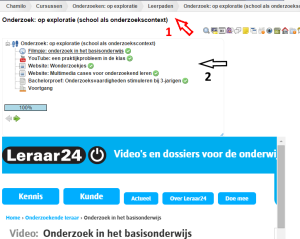I’m working a on project where we want to offer our students online learning paths which are adapted to their needs and thus take into account the very diverse student inflow we encounter. In order to construct an answer on this challenge, I will write a few blog posts.
Note: Please consider also reading the previous post where I tackled the conceptual framework of learning paths (if you want the complete story).
Can we use the learning path tool in our current LMS, if we want to benefit from the new learning path design you described in the previous post?
Let’s have a look at the screenshot above (click to enlarge) of a learning path within a traditional LMS . The red arrow (1) illustrates the ‘position’ of our learning path within the LMS. Our learning path is an object within the tool ‘learning paths’, which is part of a specific course, within the course module of the LMS. The black arrow (2) points to the list of learning objects within the learning path: a sequenced order of objects containing text, movies etc. Underneath (there’s also an option to show the content on the right side) this list, we see (a part) of the first learning object out of the list, in this case an embedded video (blue color).
If we control for the design characterics we described as essential for good learning paths in the previous post, we can easily notice the lack of possibility to annotate, like or even discuss the object. In addition we note there is no possibility for the learners to add their own learning objects or to choose the objects of their choice.
I’m not familiar with your LMS, but I guess most traditional LMS are not suitable to provide a contemporary learning experience. But I might be wrong. Please leave a comment if you think otherwise!


2 thoughts on “Rethinking learning paths: test our ideas against the traditional LMS”